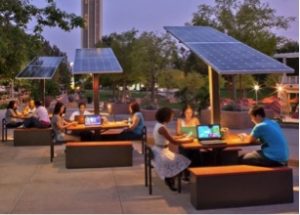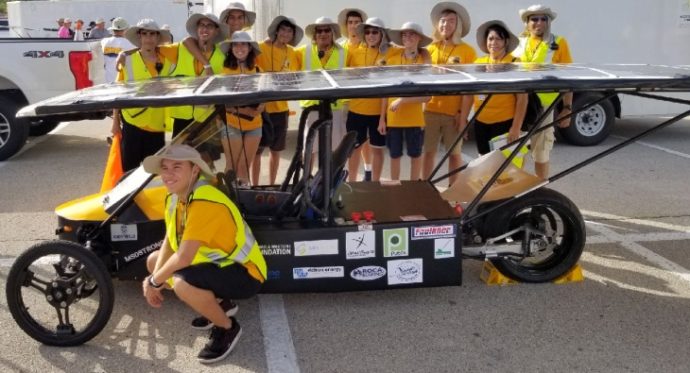JUNO BEACH, Fla., July 31, 2018 /PRNewswire/ — Florida Power & Light Company today announced the start of construction of its four newest solar power plants, continuing to build on the success of its affordable clean energy strategy that has helped Florida become a leader in clean energy while keeping customer bills among the lowest in America.
Today, FPL operates 14 major solar power plants and more than 200 smaller solar installations, totaling more than 935 megawatts of universal solar capacity currently powering customers. The four new plants, which are expected to be operational by early 2019, are:
- FPL Interstate Solar Energy Center, St. Lucie County
- FPL Miami-Dade Solar Energy Center, Miami-Dade County
- FPL Pioneer Trail Solar Energy Center, Volusia County
- FPL Sunshine Gateway Solar Energy Center, Columbia County
“Florida is leading the nation in implementing solar energy affordably,” said Eric Silagy, FPL’s president and CEO. “FPL is among the cleanest energy providers in the nation not because of governmental mandates or requirements, but because we’ve been committed to making smart investments in clean energy technologies for years. And we’ve proven that it’s possible to be both clean and reliable while keeping our customers’ electric bills among the lowest in the nation.”
According to a recent report from GTM Research and the Solar Energy Industries Association, Florida has installed more solar capacity in 2018 than any other state except one.
One of the cleanest electric companies in the nation, FPL projects that solar will outpace coal and oil combined as a percentage of the company’s energy mix by the year 2020. FPL is aiming to have approximately 10 million solar panels in operation by 2022 and will be more than halfway to its goal once these four newest plants are completed.
Each of the four new solar plants will have a capacity of 74.5 megawatts for a total of nearly 300 megawatts. In addition to the enormous environmental benefits, FPL’s four new solar power plants are expected to produce estimated net lifetime savings of more than $40 million for FPL customers through fuel and other savings.
FPL Interstate Solar Energy Center
The newest solar power plant coming to St. Lucie County will join three others along the Treasure Coast that began serving FPL customers earlier this year – the FPL Loggerhead Solar Energy Center (St. Lucie County); FPL Indian River Solar Energy Center (Indian River County); and FPL Blue Cypress Solar Energy Center (Indian River County).
“Expanding solar energy in St. Lucie County is a big win for our residents,” said Peter Tesch, president of the Economic Development Council of St. Lucie County. “It is a great way to utilize the land due to its environmentally friendly attributes. Our residents will benefit from the clean energy generated right here in our county.”
FPL Miami-Dade Solar Energy Center
FPL plans to add more than 1 million solar panels across Miami-Dade in the coming years, starting with the FPL Miami-Dade Solar Energy Center located off Krome Avenue in southwest Miami-Dade County.
“I am proud to have Miami-Dade County partner with Florida Power & Light to bring clean, renewable solar energy to South Florida,” said Miami-Dade County Mayor Carlos A. Gimenez. “Miami-Dade County is committed to a clean and sustainable future for all of our residents and this is another step in the right direction toward resiliency.”
“Resiliency is one of Miami-Dade County’s top priorities and these solar projects are one of the ways the County is partnering with the business community to address our sustainability,” said Miami-Dade County Commission Chairman Esteban Bovo, Jr. “I applaud FPL’s commitment to generate more solar power in Miami-Dade County and for being a partner to build smarter for the future of all our residents.”
FPL Pioneer Trail Solar Energy Center
Known for its beaches and Daytona International Speedway (where FPL operates one of the largest solar installations at any sporting venue in the U.S.), Volusia County will soon be home to a new 74.5-megawatt solar power plant.
“FPL’s installation of this new solar energy center in Volusia County moves us closer toward our Sustainability Action Plan goals,” said Katrina Locke, the county’s sustainability and natural resources director. “Renewable energy is a great way to help reduce our greenhouse gas emissions and protect our natural resources in Volusia County for future generations.”
FPL Sunshine Gateway Solar Energy Center
Located near the intersection of Interstates 10 and 75 near Florida’s northern border, the FPL Sunshine Gateway Solar Energy Center will give residents and visitors traveling these roads a glimpse of a major solar energy operation at work. Once completed, the solar energy center will be visible from Interstate 75 southbound and Interstate 10 westbound.
“Columbia County is proud to join FPL’s growing fleet of solar power plants. The economic boost from this project will be felt across the county in the form of jobs and additional tax revenues for our area,” said Glenn Hunter, executive director of economic development for Columbia County.
Innovative Environmental Partnerships
FPL continues to expand its solar stewardship program with environmental organizations, such as Audubon Florida, to enhance the environments encompassing the solar plants. The stewardship programs include planting additional pollinator habitats and preserving environmentally sensitive areas.
“Our beautiful state has an abundance of sun and great diversity of native plant and animal species. What is exciting about FPL’s solar sites is that they are being designed to do more than just generate clean energy – they are incorporating elements in their designs that could benefit wildlife for generations,” said Julie Wraithmell, executive director of Audubon Florida.
Advanced Battery Storage Systems
FPL and other NextEra Energy companies are actively researching and testing battery-storage technologies to study a variety of potential benefits ranging from grid stabilization to improved solar integration. Currently, NextEra Energy companies operate a total of approximately 140 megawatts of batteries with more than 150 megawatt-hours of storage capacity.
Earlier this year, FPL announced the first-of-its-kind large-scale application of “DC-coupled” batteries in the country – a 4-megawatt/16-megawatt-hour storage system located at the FPL Citrus Solar Energy Center in DeSoto County – along with the nation’s largest solar-plus storage system – a 10-megawatt/40-megawatt-hour battery-storage project located at the FPL Babcock Ranch Solar Energy Center in Charlotte County.
More information about solar in Florida and FPL’s solar investments
Florida has abundant agriculture land and ranks ninth in the nation for solar resource – the strength of the sun’s rays – making it a great place for universal scale solar; and currently, the Sunshine State ranks eighth overall in the country for total installed solar capacity, jumping five other states in the past year alone.
FPL has been studying and operating solar technology in Florida for more than three decades. In 1984, FPL commissioned its first universal scale solar installation, a 10-kilowatt photovoltaic facility in Miami that helped the company’s employees gain experience with the then-emerging technology. Over the years, FPL has continued to test and operate a wide variety of solar technologies In 2009, FPL built what was then the largest solar PV facility in America and in 2016, FPL became the first company to build solar cost effectively in Florida, leveraging its purchasing power and sites with key advantages to complete three 74.5-megawatt solar power plants projected to produce net savings for FPL customers.
FPL is the largest generator of solar energy in Florida and among the largest in the nation with 14 major solar power plants and more than 200 universal solar installations, totaling more than 935 megawatts of solar generation in operation, including:
- FPL Babcock Ranch Solar Energy Center, Charlotte County
- FPL Barefoot Bay Solar Energy Center, Brevard County
- FPL Blue Cypress Solar Energy Center, Indian River County
- FPL Citrus Solar Energy Center, DeSoto County
- FPL Coral Farms Solar Energy Center, Putnam County
- FPL DeSoto Next Generation Solar Energy Center, DeSoto County
- FPL Loggerhead Solar Energy Center, St. Lucie County
- FPL Hammock Solar Energy Center, Hendry County
- FPL Horizon Solar Energy Center, Alachua and Putnam counties
- FPL Indian River Solar Energy Center, Indian River County
- FPL Manatee Solar Energy Center, Manatee County
- FPL Martin Next Generation Clean Energy Center (hybrid solar/natural gas), Martin County
- FPL Wildflower Solar Energy Center, Desoto County
- FPL Space Coast Next Generation Solar Energy Center, Brevard County
- FPL Solar Circuit at Daytona International Speedway, Volusia County
- Solar research installation at Florida International University, Miami-Dade County
- Numerous FPL SolarNow arrays in local communities
For more information, visit www.FPL.com/solar.
Florida Power & Light Company
Florida Power & Light Company is the third-largest electric utility in the United States, serving nearly 5 million customer accounts or an estimated 10 million+ people across nearly half of the state of Florida. FPL’s typical 1,000-kWh residential customer bill is approximately 30 percent lower than the latest national average and among the lowest in the U.S. FPL’s service reliability is better than 99.98 percent, and its highly fuel-efficient power plant fleet is one of the cleanest among all utilities nationwide. The company was recognized in 2017 as one of the most trusted U.S. electric utilities by Market Strategies International for the fourth consecutive year. A leading Florida employer with approximately 8,700 employees, FPL is a subsidiary of Juno Beach, Florida-based NextEra Energy, Inc. (NYSE: NEE), a clean energy company widely recognized for its efforts in sustainability, ethics and diversity, and has been ranked No. 1 in the electric and gas utilities industry in Fortune’s 2018 list of “World’s Most Admired Companies.” NextEra Energy is also the parent company of NextEra Energy Resources, LLC, which, together with its affiliated entities, is the world’s largest generator of renewable energy from the wind and sun. For more information about NextEra Energy companies, visit these websites: www.NextEraEnergy.com, www.FPL.com, www.NextEraEnergyResources.com.
Cautionary Statements and Risk Factors That May Affect Future Results
This news release contains “forward-looking statements” within the meaning of the safe harbor provisions of the Private Securities Litigation Reform Act of 1995. Forward-looking statements are not statements of historical facts, but instead represent the current expectations of NextEra Energy, Inc. (NextEra Energy) and Florida Power & Light Company (FPL) regarding future operating results and other future events, many of which, by their nature, are inherently uncertain and outside of NextEra Energy’s and FPL’s control. Forward-looking statements in this news release include, among others, statements concerning adjusted earnings per share expectations and future operating performance. In some cases, you can identify the forward-looking statements by words or phrases such as “will,” “may result,” “expect,” “anticipate,” “believe,” “intend,” “plan,” “seek,” “potential,” “projection,” “forecast,” “predict,” “goals,” “target,” “outlook,” “should,” “would” or similar words or expressions. You should not place undue reliance on these forward-looking statements, which are not a guarantee of future performance. The future results of NextEra Energy and FPL and their business and financial condition are subject to risks and uncertainties that could cause their actual results to differ materially from those expressed or implied in the forward-looking statements, or may require them to limit or eliminate certain operations. These risks and uncertainties include, but are not limited to, the following: effects of extensive regulation of NextEra Energy’s and FPL’s business operations; inability of NextEra Energy and FPL to recover in a timely manner any significant amount of costs, a return on certain assets or a reasonable return on invested capital through base rates, cost recovery clauses, other regulatory mechanisms or otherwise; impact of political, regulatory and economic factors on regulatory decisions important to NextEra Energy and FPL; disallowance of cost recovery by FPL based on a finding of imprudent use of derivative instruments; effect of any reductions or modifications to, or elimination of, governmental incentives or policies that support utility scale renewable energy projects of NextEra Energy Resources, LLC and its affiliated entities (NextEra Energy Resources) or the imposition of additional tax laws, policies or assessments on renewable energy; impact of new or revised laws, regulations, interpretations or other regulatory initiatives on NextEra Energy and FPL; capital expenditures, increased operating costs and various liabilities attributable to environmental laws, regulations and other standards applicable to NextEra Energy and FPL; effects on NextEra Energy and FPL of federal or state laws or regulations mandating new or additional limits on the production of greenhouse gas emissions; exposure of NextEra Energy and FPL to significant and increasing compliance costs and substantial monetary penalties and other sanctions as a result of extensive federal regulation of their operations and businesses; effect on NextEra Energy and FPL of changes in tax laws, guidance or policies as well as in judgments and estimates used to determine tax-related asset and liability amounts; impact on NextEra Energy and FPL of adverse results of litigation; effect on NextEra Energy and FPL of failure to proceed with projects under development or inability to complete the construction of (or capital improvements to) electric generation, transmission and distribution facilities, gas infrastructure facilities or other facilities on schedule or within budget; impact on development and operating activities of NextEra Energy and FPL resulting from risks related to project siting, financing, construction, permitting, governmental approvals and the negotiation of project development agreements; risks involved in the operation and maintenance of electric generation, transmission and distribution facilities, gas infrastructure facilities and other facilities; effect on NextEra Energy and FPL of a lack of growth or slower growth in the number of customers or in customer usage; impact on NextEra Energy and FPL of severe weather and other weather conditions; threats of terrorism and catastrophic events that could result from terrorism, cyber attacks or other attempts to disrupt NextEra Energy’s and FPL’s business or the businesses of third parties; inability to obtain adequate insurance coverage for protection of NextEra Energy and FPL against significant losses and risk that insurance coverage does not provide protection against all significant losses; a prolonged period of low gas and oil prices could impact NextEra Energy Resources’ gas infrastructure business and cause NextEra Energy Resources to delay or cancel certain gas infrastructure projects and for certain existing projects to be impaired; risk to NextEra Energy Resources of increased operating costs resulting from unfavorable supply costs necessary to provide NextEra Energy Resources’ full energy and capacity requirement services; inability or failure by NextEra Energy Resources to manage properly or hedge effectively the commodity risk within its portfolio; effect of reductions in the liquidity of energy markets on NextEra Energy’s ability to manage operational risks; effectiveness of NextEra Energy’s and FPL’s risk management tools associated with their hedging and trading procedures to protect against significant losses, including the effect of unforeseen price variances from historical behavior; impact of unavailability or disruption of power transmission or commodity transportation facilities on sale and delivery of power or natural gas by FPL and NextEra Energy Resources; exposure of NextEra Energy and FPL to credit and performance risk from customers, hedging counterparties and vendors; failure of NextEra Energy or FPL counterparties to perform under derivative contracts or of requirement for NextEra Energy or FPL to post margin cash collateral under derivative contracts; failure or breach of NextEra Energy’s or FPL’s information technology systems; risks to NextEra Energy and FPL’s retail businesses from compromise of sensitive customer data; losses from volatility in the market values of derivative instruments and limited liquidity in OTC markets; impact of negative publicity; inability of NextEra Energy and FPL to maintain, negotiate or renegotiate acceptable franchise agreements with municipalities and counties in Florida; occurrence of work strikes or stoppages and increasing personnel costs; NextEra Energy’s ability to successfully identify, complete and integrate acquisitions, including the effect of increased competition for acquisitions; environmental, health and financial risks associated with NextEra Energy Resources’ and FPL’s ownership and operation of nuclear generation facilities; liability of NextEra Energy and FPL for significant retrospective assessments and/or retrospective insurance premiums in the event of an incident at certain nuclear generation facilities; increased operating and capital expenditures and/or result in reduced revenues at nuclear generation facilities of NextEra Energy or FPL resulting from orders or new regulations of the Nuclear Regulatory Commission; inability to operate any of NextEra Energy Resources’ or FPL’s owned nuclear generation units through the end of their respective operating licenses; effect of disruptions, uncertainty or volatility in the credit and capital markets on NextEra Energy’s and FPL’s ability to fund their liquidity and capital needs and meet their growth objectives; inability of NextEra Energy, FPL and NextEra Energy Capital Holdings, Inc. to maintain their current credit ratings; impairment of NextEra Energy’s and FPL’s liquidity from inability of credit providers to fund their credit commitments or to maintain their current credit ratings; poor market performance and other economic factors that could affect NextEra Energy’s defined benefit pension plan’s funded status; poor market performance and other risks to the asset values of NextEra Energy’s and FPL’s nuclear decommissioning funds; changes in market value and other risks to certain of NextEra Energy’s investments; effect of inability of NextEra Energy subsidiaries to pay upstream dividends or repay funds to NextEra Energy or of NextEra Energy’s performance under guarantees of subsidiary obligations on NextEra Energy’s ability to meet its financial obligations and to pay dividends on its common stock; the fact that the amount and timing of dividends payable on NextEra Energy’s common stock, as well as the dividend policy approved by NextEra Energy’s board of directors from time to time, and changes to that policy, are within the sole discretion of NextEra Energy’s board of directors and, if declared and paid, dividends may be in amounts that are less than might be expected by shareholders; NEP’s inability to access sources of capital on commercially reasonable terms could have an effect on its ability to consummate future acquisitions and on the value of NextEra Energy’s limited partner interest in NextEra Energy Operating Partners, LP; and effects of disruptions, uncertainty or volatility in the credit and capital markets on the market price of NextEra Energy’s common stock. NextEra Energy and FPL discuss these and other risks and uncertainties in their annual report on Form 10-K for the year ended December 31, 2017 and other SEC filings, and this news release should be read in conjunction with such SEC filings made through the date of this news release. The forward-looking statements made in this news release are made only as of the date of this news release and NextEra Energy and FPL undertake no obligation to update any forward-looking statements.
SOURCE Florida Power & Light Company
For further information: Florida Power & Light Company, Media Line: 561-694-4442, @FPL_Newsroom

















